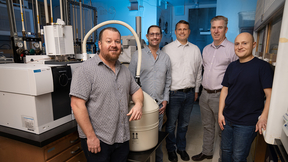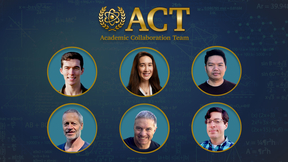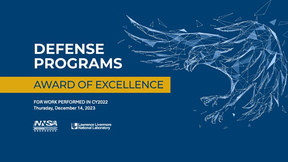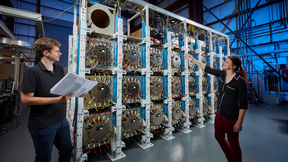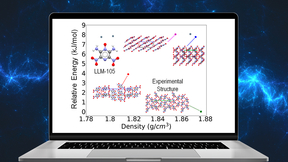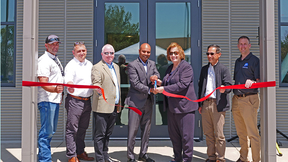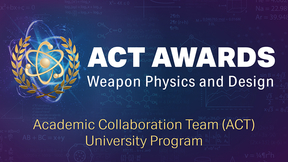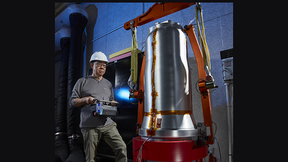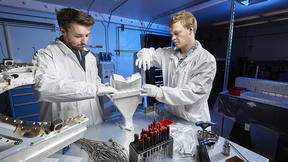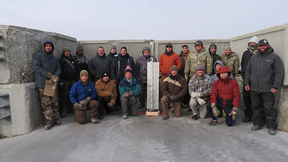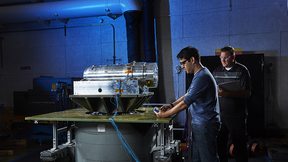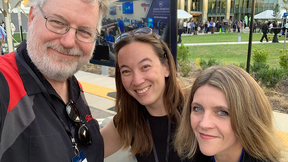Back
The University of California (UC) and Lawrence Livermore National Laboratory (LLNL) have a storied history going back to the founding of the Laboratory in 1952. The work conducted at the Lab since that time has benefited in many areas from successful collaboration with researchers and contributors within the UC system. In the spirit of continued collaboration, a UC Early…
TATB (1,3,5-triamino-2,4,6-trinitrobenzene) is an important explosive compound because of its extensive use in munitions and world-wide weapons systems. Despite its importance, researchers have been trying to understand its response to temperature extremes for the past 50 years. A Lawrence Livermore National Laboratory (LLNL) team has uncovered a new thermal decomposition…
Six scientists at the Lawrence Livermore National Laboratory (LLNL) were recently granted awards through the Lab’s 2023 Academic Collaboration Team (ACT) annual call for proposals. Awards support university research partners for up to three years to perform research in collaboration with Lab scientists and offer an important way to build long-term connections with…
In a virtual ceremony held Dec. 14, Lawrence Livermore National Laboratory (LLNL) and the National Nuclear Security Administration (NNSA) recognized six teams of LLNL researchers with the Defense Programs Award of Excellence. One additional award was acknowledged following the ceremony. The awards commend outstanding contributions made in calendar year 2022. LLNL Deputy…
In the quest to understand how nuclear debris forms, a team of scientists at Lawrence Livermore National Laboratory (LLNL) has developed an approach to studying the oxidation mechanism of gas phase uranium in extreme environments. In research recently published in Scientific Reports, the team outlined their work, which combined experimental data from a plasma flow reactor …
Members of Lawrence Livermore National Laboratory’s (LLNL’s) Advanced Sources and Detectors (ASD) Scorpius accelerator team recently marked a major milestone in the project — the delivery of 24 line-replaceable units (LRUs), known as pulsers, forming a complete unit cluster. The LRUs will power the Scorpius electron beam accelerator, which will capture multiple X-ray…
New research by Lawrence Livermore National Laboratory researchers and collaborators from Carnegie Mellon University (CMU) demonstrates that crystal structure prediction is a useful tool for studying the various ways the molecules can pack together, also known as ubiquitous polymorphism, in energetic materials. The research also shows promise of becoming an integral part…
The Department of Energy’s National Nuclear Security Administration (NNSA) and the Department of Defense (DoD) recently approved the W87-1 Modification Program to enter Phase 6.3, Development Engineering, through the Nuclear Weapons Council. During this phase of the nuclear weapons lifecycle process, NNSA will continue to work closely with DoD to conduct experiments, tests…
Lawrence Livermore National Laboratory (LLNL) and Sandia National Laboratories (Sandia) recently successfully executed the second joint abnormal thermal environment (ATE-2) test for the W80-4 Life Extension Program (LEP). Carried out at Sandia’s Cross Wind Test Facility in New Mexico, ATE-2 was a fast-heat, fully engulfing system-level fuel fire test, the first for LLNL in…
Lawrence Livermore National Laboratory (LLNL) and directorate leadership held dual ribbon-cutting ceremonies on May 24, officially marking the opening of the Lab’s Advanced Characterization and Evaluation Laboratory (ACEL) and newest advanced manufacturing facility. The ACEL will serve LLNL’s Nondestructive Evaluation (NDE) group and the Nondestructive Characterization…
Six scientists at Lawrence Livermore National Laboratory were recently granted awards through the Lab's 2022 Academic Collaboration Team (ACT) annual call for proposals. Now in their fourth year, ACT university collaboration awards were created to encourage and advance strategic partnerships among universities with a focus on the Lab’s and Weapons and Complex Integration’s…
In March, the Department of Energy’s National Nuclear Security Administration's Deputy Administrator for Defense Programs approved the W80-4 Life Extension Program (LEP) to transition into Phase 6.4, Production Engineering. The W80-4 LEP achieved Phase 6.4 entry following successful execution of the Preliminary Design Review and Acceptance Group Review and the System…
Third in a series of articles describing the elements of Lawrence Livermore National Laboratory's fusion breakthrough. When scientists at Lawrence Livermore National Laboratory (LLNL) achieved fusion ignition at the National Ignition Facility (NIF) on Dec. 5, 2022 — an extraordinary scientific breakthrough that was decades in the making — the primary mission and driving…
Lawrence Livermore National Laboratory (LLNL) scientists and engineers led a multi-institutional team in executing a series of high explosives tests that successfully demonstrated fundamental principles of anisotropy, a possible enabler for improved weapon and munition safety. Working under snowy and frigid conditions on Idaho’s Snake River Plain, a 13-member team from…
The W80-4 Life Extension Program team in November successfully executed the Preliminary Design Review and Acceptance Group (PDRAAG) review at the Air Force Nuclear Weapons Center on Kirtland Air Force Base in Albuquerque, New Mexico. Review by the PDRAAG is a critical mid-program review with the Department of Defense to show the warhead baseline design complies with DOD…
Researchers at Lawrence Livermore National Laboratory (LLNL) have discovered that ions behave differently in fusion reactions than previously expected, thus providing important insights for the future design of a laser–fusion energy source. The findings are featured in a new paper in the Nov. 14 issue of Nature Physics and is titled “Evidence for suprathermal ion…
It was a scene right out of the movies. NASA’s DART spacecraft successfully impacted its asteroid target in the world’s first planetary defense technology demonstration at 4:14 p.m. (PDT) on Sept. 26. Two weeks after impact, NASA has confirmed the mission changed the asteroid’s motion in space. “We were anxiously awaiting the spacecraft’s final hours with the DART…
Physicist Tom Ramos has had several roles for the past 40 years at Lawrence Livermore National Laboratory. He served as a member of the nuclear team that developed the X-ray laser for President Reagan’s Strategic Defense Initiative, he supported United States arms control negotiations for START, and over a span of seventeen years he created and ran a program for the…
The last nuclear test, code-named Divider, took place 30 years ago, on Sept. 23, 1992. That year, President Bush declared a temporary moratorium on nuclear testing, which became permanent during the Clinton administration. This ending of the era of nuclear testing was also the beginning of stockpile stewardship. Leaders from the Department of Energy (DOE), and Lawrence…
Scientific discovery during the Stockpile Stewardship Program maintains confidence in the nuclear deterrent without testing, brings other benefits The last nuclear test, code-named Divider, took place 30 years ago, on September 23, 1992. That year, President Bush declared a temporary moratorium on nuclear testing, which became permanent during the Clinton administration…


